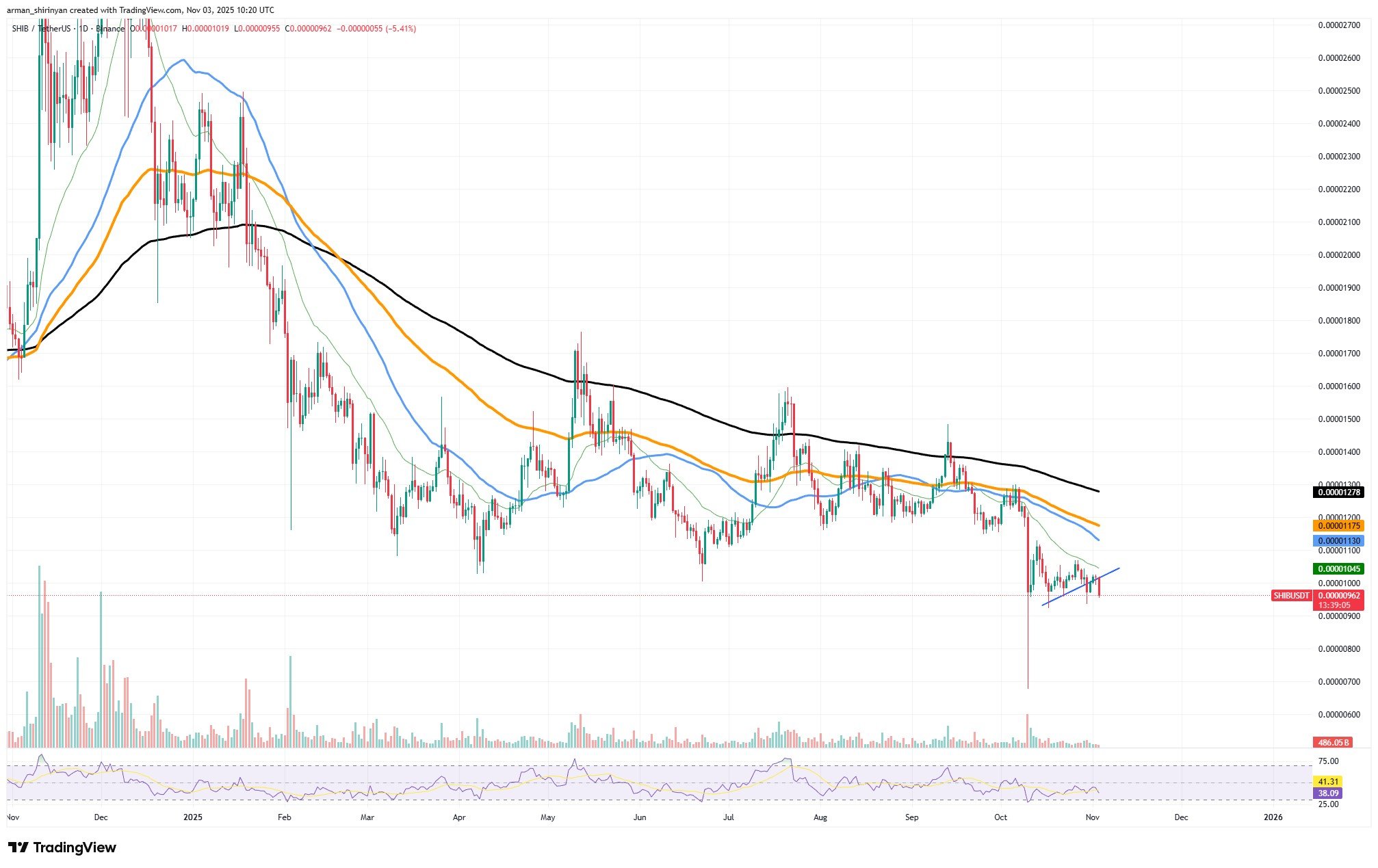SHIB exchange reserves have dropped to 81.2 trillion tokens, signaling a rapid outflow from centralized exchanges as per CryptoQuant data. This netflow decline of -81.2 billion SHIB in the last 24 hours indicates accumulation trends amid a 5% price drop to $0.0000096, potentially tightening supply and increasing volatility.
-
SHIB reserves fall below 82 trillion: On-chain metrics from CryptoQuant show a quickening outflow, with 81.2 trillion tokens now held on exchanges.
-
Negative netflows persist: The 24-hour netflow stands at -81.2 billion SHIB, reflecting more tokens leaving than entering platforms.
-
Bearish technical signals: SHIB price rejects key moving averages, with RSI below 40 and declining volume, per TradingView charts.
Discover the latest on SHIB exchange reserves dropping to 81.2 trillion tokens amid negative netflows. Explore implications for Shiba Inu price and market dynamics. Stay informed on crypto trends today!
What Are the Current SHIB Exchange Reserves and Netflows?
SHIB exchange reserves currently stand at approximately 81.2 trillion tokens, a notable decrease from the 82 trillion threshold, according to on-chain data tracked by CryptoQuant. This decline reflects a steady outflow over recent days, with the 24-hour netflow reaching -81.2 billion SHIB, indicating more tokens are being withdrawn from exchanges than deposited. Such movements often point to investor accumulation for long-term holding rather than immediate trading.
How Do Negative SHIB Netflows Impact Market Sentiment?
Negative netflows in SHIB suggest a shift toward private holding, which can reduce available supply on exchanges and potentially support future price stability. Data from CryptoQuant highlights that this outflow has accelerated in the past week, coinciding with broader market pressures on meme coins. For instance, similar patterns in 2024 led to temporary volatility before recoveries, as investors moved assets off platforms to hardware wallets.
Experts note that while short-term price dips may occur, sustained outflows below key reserve levels like 81 trillion could signal bullish long-term sentiment. A report from blockchain analytics firm CryptoQuant emphasizes that reduced exchange liquidity often correlates with decreased selling pressure. However, this must be weighed against current bearish indicators, where SHIB’s price has fallen over 5% in the last day to around $0.0000096.
Trading volume has also declined, further underscoring cautious market participation. Analysts from Glassnode, another on-chain data provider, have observed that netflow negatives in assets like SHIB typically precede periods of consolidation, allowing prices to stabilize before upward movements. This dynamic is particularly relevant for Shiba Inu, given its high liquidity and community-driven ecosystem.

SHIB/USDT Chart by TradingView
The interplay between outflows and price action creates a nuanced picture: while reserves dwindle, signaling potential accumulation, the ongoing price rejection adds layers of uncertainty. Investors monitoring SHIB should consider these metrics alongside overall cryptocurrency market trends, such as Bitcoin’s influence on altcoins.
In the context of Shiba Inu’s ecosystem, these netflows align with developments in its Shibarium layer-2 solution, which has seen increased transaction activity. Data indicates that off-exchange movements may be tied to staking or DeFi integrations, reducing the tokens available for spot trading. This structural shift could enhance SHIB’s resilience against volatility, as per observations from Chainalysis reports on token distribution.
Frequently Asked Questions
What Does It Mean If SHIB Exchange Reserves Drop Below 81 Trillion?
A drop below 81 trillion SHIB on exchanges signals reduced liquidity and potential accumulation by holders moving tokens to private wallets. According to CryptoQuant, this level is critical for market structure, often leading to tighter supply that may curb immediate sell-offs but heighten short-term price swings. Historically, such thresholds have preceded volatility spikes of up to 10% in similar assets.
Why Is SHIB Experiencing Negative Netflows Right Now?
SHIB’s negative netflows stem from investors withdrawing tokens amid a declining price environment, favoring long-term storage over trading. This natural response to market dips, as seen in recent CryptoQuant updates, reflects broader sentiment toward holding during corrections. When spoken aloud, it’s clear: more SHIB is leaving exchanges, potentially setting the stage for recovery as supply tightens on platforms.
Key Takeaways
- Declining Reserves Signal Accumulation: SHIB exchange holdings at 81.2 trillion indicate outflows that could reduce selling pressure over time.
- Technical Rejection Adds Caution: Price failure at moving averages and low RSI suggest bearish short-term momentum, per TradingView analysis.
- Monitor for Volatility: Lower liquidity may boost long-term bullishness but increase swings—track netflows for entry points.
Conclusion
The ongoing decline in SHIB exchange reserves to 81.2 trillion tokens, coupled with negative netflows of -81.2 billion in the last day, underscores shifting dynamics in Shiba Inu’s market. As technical indicators like RSI below 40 highlight bearish pressures, these on-chain trends from sources such as CryptoQuant point to accumulation that may foster future stability. Investors should stay vigilant on exchange liquidity and broader crypto sentiment, positioning themselves for potential rebounds in this evolving landscape.
